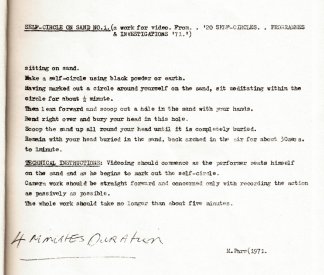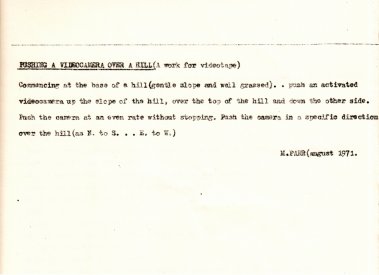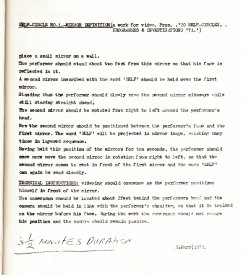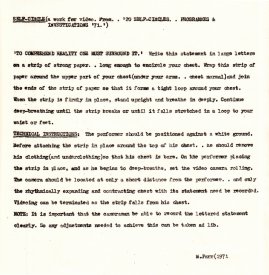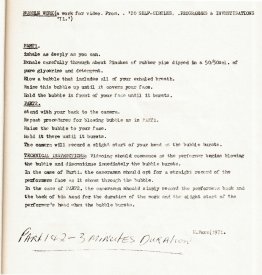Parr grew up in rural Queensland. He went to the University of Queensland In Brisbane to study Arts/Law (1965) and began writing poetry. He also helped set up Students for a Democratic Society (SDS), and engaging in anti-Vietnam war demonstrations. Despite being medically unfit he refused to register for conscription and became the target of the Commonwealth Police as well.
However, he dropped out of university and moved to Sydney. In 1968 he enrolled in the National Arts School (East Sydney Tech) to study painting, from which he rapidly moved on and began exploring more conceptual and textual (concrete or visual poetry) ways of working.1 This led to the idea of establishing an artists' run gallery and Parr called a meeting in August 1970 from which Inhibodress was set up, with Peter Kennedy and Tim Johnson being the other two mainstays. Parr's first solo show at Inhibodress, Word Situations 1 (March, 1971), demonstrated his interest in the concrete representation of words such that the visual manifestation (typescript on paper) reflected the literal meanings of the words.2 At the end of 1970 Tim Johnson went to the UK and, on his return, produced his show Out of the Gallery – Installation as Conceptual Scheme (April, 1971). Meanwhile Peter Kennedy had presented his installation, But the Fierce Blackman (March, 1971), which actually used a de-tuned TV set as the main source of light. Then in May 1971 Johnson organised the Activities, Performance, Participation and Art by Instruction show at Inhibodress, in which a lot of the work used unconventional media. So by mid-1971 the use of a wide range of media had become established, however, Parr notes that he did not know about video until perhaps the middle of that year.3 The trigger may have been the video documentation of Bruce Copping's installation at Inhibodress – Studio and Video – in which he laced string throughout the gallery and into the street and which was recorded to 1/4” Akai portapak video daily (with playback of the day's work in the gallery) by Albie Thoms and Peter Wright, then of the Yellow House. Video had become one of the many ways in which Donald Brook's notion of the Post-Object led to a transition in the way artists were working.4
At this period around the middle of 1971 Parr and Kennedy began writing instructions for performance pieces and this led to them actually carrying out some of these instructions.5 Then sometime in later July or August they borrowed the Akai portapak and over a weekend recorded performances of a number of these instructional pieces. Parr's works recorded during this period included several of the Self Circles pieces and others such as To Comprehend Reality One must Surround It and Bubble Work
Parr's earliest video work is Pushing a Camera Over a Hill in which the actual performance of the action of crawling up the hill, pushing the camera, is invisible. It is made available only by implication and it is the camera's experience to which we have access. The camera is at ground level, pushing its way through the grass until its view is liberated on reaching the top of the hill, revealing the valley below, before it descends into the valley beyond. The sound recorded in the process is that of the camera brushing through the grass. Along with the recordings made with the Akai portapak, it was shown as part of Video Tapes at Inhibodress in November and December 1971. This was to be two evenings of showings of the collected recordings but the difficulties of getting an adequate playback from the Akai led to the first evening being aborted, although the second evening worked rather better. But the general problems of low resolution, inadequate response to the light, and the general difficulties associated with getting a good playback of any recording meant that Parr and Kennedy decided that they should re-make the performances and situations to 16mm film. To this end they enlisted the help of Aggy Read and Ian Stocks and filmed a revised collection of works that became Idea Demonstrations.6
Parr sees himself as an outsider “with a need not simply to represent his world [his subjectivity (interp. SJ)] but to dissect it, to find a way to understand it and to make it his own.” [Scheer, p1]. To a great extent this approach led to his concentration on performance as a medium. Since he began his early performance works, they have usually been documented or, more importantly, actually mediated and made visible through the use of video and film. The main point about performance art(work) that aligns it with video/film recording is that it is the enactment of a process and as all processes take time to unfold, the time-based media are the most appropriate way of documenting that process.
Early In 1973 Parr travelled abroad for the first time, making Vienna his base (as he did again in 1977-8). He carried out performances in Lausanne and Neuchatel, Switzerland. These works (and the associated filmed record) were collectively entitled Performances, Actions, Video Systems and developed out of works previously made in Sydney: Word Situations (1971) and Idea Demonstrations (1971-2).
His next project, again film, was Rules and Displacement Activities, Part 1 (1974), in which he performed a number of extremely difficult and disturbing works. This series of films continued through parts 2 (1975-76) and 3 (1983). Since then many of his performances have been videotaped as documentation.
- 1. http://www.nga.gov.au/landscapes/Par.htm
- 2. Sue Cramer, Inhibodress 1970-1972, Brisbane: Institute of Modern Art, (1989).
- 3. Mike Parr, interview with Stephen Jones, recorded 26 August, 2010.
- 4. Brook discusses video and Parr and Kennedy's Idea Demonstrations film in Donald Brook, “Idea Demonstrations: body art and 'video freaks' in Sydney”, Studio International, June 1973, vol.185, no.956, pp.269-273.
- 5. Ibid.
- 6. Donald Brook, “Idea Demonstrations: body art and 'video freaks' in Sydney”, Studio International, June 1973, vol.185, no.956, pp.269-273.
Parr's works that appear on video (many of which were shot on film) include:
Performances (1972-75) colour and black and white video, sound, 39min 30sec.
Cathartic action: social gestus No. 5 (1977). colour, sound, 30 min.
Family Under Water (1978) black and white video, sound, 30min
Black Book, 4 performances, The Gunnery, Sydney, 12 December 1992
100 Breaths (1994), http://www.youtube.com/watch?v=nw0xv__mokY&feature=related
End of Nature (1998), performance, walking across a frozen Baltic Sea as the Bride, 16 February 1998.
Bloodbox (1998), 24 hour performance, 6-7 September 1998, Artspace,
Water From The Mouth (2001), Artspace, 26 April to 5 May, 2001.
Malevich: A Political Arm (2002) Artspace 3-5 May, 2002.
Aussie, Aussie, Aussie, Oi, Oi, Oi [UnAustralian], performance, Artspace, May 2 - 3, 2003
http://www.artgallery.nsw.gov.au/work/360.2003/
House of Cards (2004)
AMERIKA, performance for as long as possible, Art Gallery of NSW, 9-12 May 2006
http://www.artgallery.nsw.gov.au/work/347.2007.2/
Minor/ Major (2008), HDV video recording, 16:9, colour, sound
http://www.artgallery.nsw.gov.au/work/408.2011/
Cartesian Corpse, performance for as long as possible, 21-22 November 2008, HDV video recording, 16:9, colour, sound, 2 hours
http://www.artgallery.nsw.gov.au/work/403.2011/
